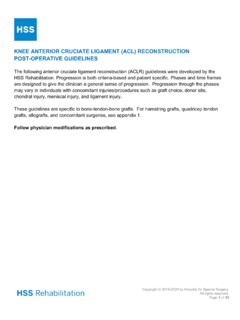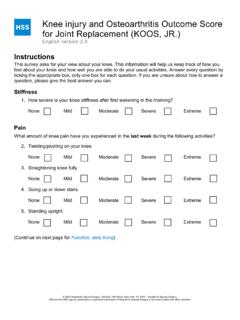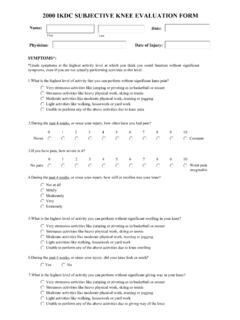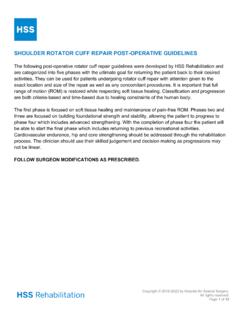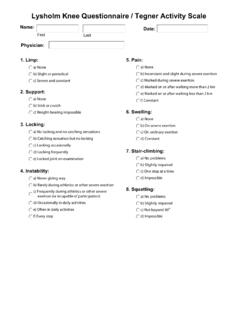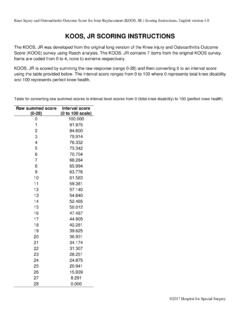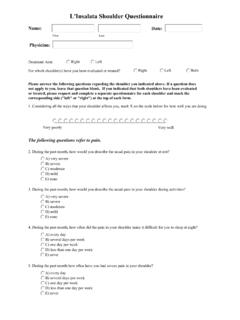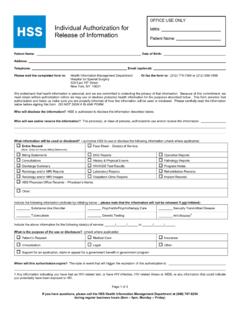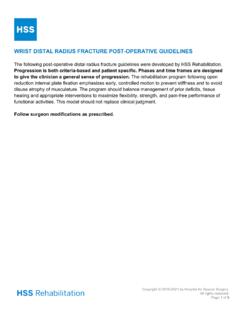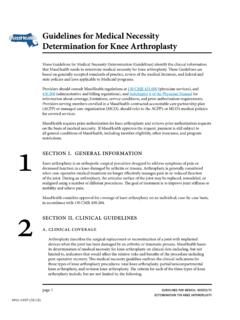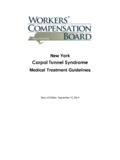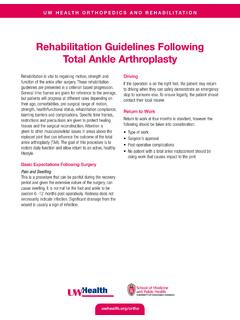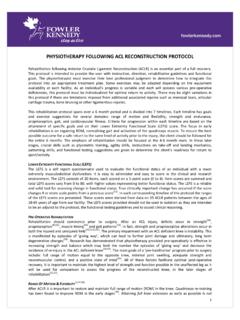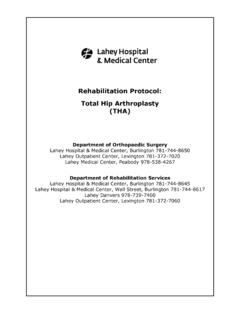Transcription of TOTAL KNEE ARTHROPLASTY POST-OPERATIVE …
1 Copyright 2017-2021 by Hospital for Special Surgery. All rights reserved. Page 1 of 11 TOTAL knee ARTHROPLASTY POST-OPERATIVE guidelines The following TOTAL knee ARTHROPLASTY guidelines were developed by HSS Rehabilitation. Progression is both criteria-based and patient specific. Phases and time frames are designed to give the clinician a general sense of progression. The rehabilitation program following TOTAL knee ARTHROPLASTY emphasizes early, controlled motion to prevent knee stiffness and to avoid disuse atrophy of musculature. The program should balance the aspects of tissue healing and appropriate interventions to maximize flexibility, strength, and pain-free performance of functional activities.
2 This model should not replace clinical judgment. Follow surgeon modifications as prescribed. Copyright 2017-2021 by Hospital for Special Surgery. All rights reserved. Page 2 of 11 TOTAL knee ARTHROPLASTY POST-OPERATIVE guidelines Pre- operative Phase PRECAUTIONS Modify/minimize activities and/or exercises that increase pain Maintain activity level to avoid deconditioning and atrophy ASSESSMENT Lower Extremity Functional Scale (LEFS) knee disability and Osteoarthritis Outcome Survey, Junior (KOOS JR) Pain Home environment- define barriers and available resources knee active range of motion (ROM) flexion and extension Pre- operative gait quality, distance and use of assistive device TREATMENT RECOMMENDATIONS Targeted core and lower extremity strengthening Targeted lower extremity stretching Functional mobility and transfer training Balance training Independent with home exercise program (HEP)
3 That addresses primary impairments Familiarize with POST-OPERATIVE plan of care, mobility, use of assistive device, and discharge planning CRITERIA FOR ADVANCEMENT Patient able to verbalize POST-OPERATIVE plan of care EMPHASIZE Familiarize with POST-OPERATIVE plan of care Improve flexibility prior to surgery Improve lower extremity and core strength prior to surgery Improve balance prior to surgery Copyright 2017-2021 by Hospital for Special Surgery. All rights reserved. Page 3 of 11 TOTAL knee ARTHROPLASTY POST-OPERATIVE guidelines Acute Care Phase (Week 1) PRECAUTIONS Avoid prolonged sitting, standing, and walking Avoid severe pain with strengthening and ROM exercises Avoid pillow under knee to prevent knee flexion contracture ASSESSMENT Mental status Pain Wound status Swelling AROM/PROM of knee post -anesthesia sensory motor screening Functional status Gait and stair ability Assess for compromised cardiovascular status TREATMENT RECOMMENDATIONS Therapeutic exercise with focus on active ROM, active quadriceps contraction, and muscle pumping ( quadricep sets and ankle pumps)
4 Promote knee extension activities Transfer training: in and out of bed and sit to stand ( chair, toilet) Gait training with appropriate device, progressing from rolling walker to cane/crutches when patient demonstrates adequate weight bearing Non-reciprocal stair training with assistive device Activities of daily living (ADL) training Cryotherapy and elevation of lower extremity to prevent swelling Initiate and emphasize importance of HEP Continuous passive motion machine only if indicated by surgeon CRITERIA FOR ADVANCEMENT Active knee flexion ROM ~80 in sitting and active extension ROM <10 in supine Good pain control Transfers unassisted from supine to sit and sit to stand safely Ambulates safely with appropriate device on level surfaces and stairs Independent with home exercise program Copyright 2017-2021 by Hospital for Special Surgery.
5 All rights reserved. Page 4 of 11 Discharge home within same day or up to 2 days post -operatively, when goals have been achieved and with surgeon clearance EMPHASIZE Control swelling Independent transfers Household ambulation with appropriate assistive device Pain-free basic exercises AROM (emphasize extension) Copyright 2017-2021 by Hospital for Special Surgery. All rights reserved. Page 5 of 11 TOTAL knee ARTHROPLASTY POST-OPERATIVE guidelines POST-OPERATIVE Phase 1 (Weeks 2-6) PRECAUTIONS If ROM plateaus with hard or painful end feel contact surgeon Avoid prolonged sitting or walking Avoid severe pain with therapeutic exercise and functional activities Avoid reciprocal stair negotiation and ambulation without assistive device until non-antalgic gait is achieved ASSESSMENT LEFS KOOS JR Pain Active/Passive ROM, including knee flexion and extension Manual muscle testing (MMT) including.
6 Hip extensors and abductors, knee flexors and extensors, ankle plantarflexors Single leg stance (SLS) Timed Up and Go (TUG) 5x sit to stand ADL ability Gait and stair ability TREATMENT RECOMMENDATIONS ROM/Stretching o Passive extension and flexion exercises, stretching of appropriate muscle groups including quadriceps, hamstrings and gastrocnemius, and knee flexion/extension exercises Strengthening o Straight leg raise in all planes (when terminal knee extension is achieved); prioritize quadriceps, hip, and hamstring strength Endurance o Cycle ergometry: Short crank if knee flexion ROM is <90 , full crank if knee flexion ROM is >110 Modalities o Cryotherapy/elevation/modalities to help control swelling and pain o Electrical stimulation or biofeedback may be used for quadriceps reeducation Patella mobilization when incision is stable Copyright 2017-2021 by Hospital for Special Surgery.
7 All rights reserved. Page 6 of 11 Forward and lateral step up progression, step down progression (starting with 2-4 inches) Proprioception/balance training: progress bilateral dynamic activities to unilateral stance Gait training with/without assistive device with emphasis on active knee flexion and extension, heel strike, reciprocal pattern, and symmetrical weight bearing ADL training to continue such as sit to stand, in/out of tub/shower, car transfer CRITERIA FOR ADVANCEMENT Swelling and pain controlled Active ROM >110 of knee flexion, 0 of knee extension No quadriceps lag Ambulate on level surface with/without assistive device with normal gait pattern Ascend 6 steps with good control Sit to stand without compensatory motion Independent with ADL Independent with HEP EMPHASIZE Control swelling Increase flexibility Active quadriceps contraction through to terminal knee extension Functional strength and movements Normalizing gait pattern Copyright 2017-2021 by Hospital for Special Surgery.
8 All rights reserved. Page 7 of 11 TOTAL knee ARTHROPLASTY POST-OPERATIVE guidelines POST-OPERATIVE Phase 2 (Weeks 7-12) PRECAUTIONS Avoid reciprocal stair negotiation if severe pain or gait deviation present Avoid high impact activities such as running, jumping, plyometric activity and vibration platforms ASSESSMENT LEFS KOOS JR Pain AROM/PROM- knee flexion and extension Strength MMT including: hip extensors and abductors, knee flexors and extensors, ankle plantarflexors SLS 5x sit to stand ADL ability Gait and stair ability TREATMENT RECOMMENDATIONS Continuation of phase 1 manual/exercise treatments as needed Concentric and eccentric quadriceps strengthening Stretching of quadriceps, hamstring and appropriate muscles groups continued Leg press progression.
9 Bilateral, unilateral, eccentric Continue step up/step down progression (6-8 ) Ball/wall/functional squats Retro treadmill, forward treadmill, elliptical, cycle ergometry Gait training on flat and uneven surfaces Advance proprioception and balance exercise Address limitations in the kinetic chain for functional activities such as walking, squatting, stair climbing Hydrotherapy once wound is healed if available Copyright 2017-2021 by Hospital for Special Surgery. All rights reserved. Page 8 of 11 CRITERIA FOR DISCHARGE/ADVANCEMENT (IF RETURNING TO SPORT/HIGH LEVEL ADL) Active flexion > 120 and knee extension = 0 in supine Bilateral ankle dorsiflexion > 10 Functional test measures within age appropriate parameters Independent with lower extremity ADL such as tying shoelaces and donning/doffing socks Negotiate steps with reciprocal pattern and with minimal pain and deviation Lower extremity strength 4+/5, control, and flexibility for high level ADL activities Independent with full home exercise program Discharge progress onto Phase 3 if the goal is to return to sport or advanced functional activities (if cleared by surgeon)
10 EMPHASIZE Increase flexibility Restore strength symmetrical quad strength and symmetrical squat Increase endurance with walking Independence with exercise and activity regulation Reciprocal stair negotiation Copyright 2017-2021 by Hospital for Special Surgery. All rights reserved. Page 9 of 11 TOTAL knee ARTHROPLASTY POST-OPERATIVE guidelines POST-OPERATIVE Phase 3 (Weeks 13-18); Begin only if returning to sport with surgeon clearance PRECAUTIONS Avoid high impacts Note: expert opinion varies widely on allowable sports consult with surgeon ASSESSMENT LEFS KOOS JR Flexibility Strength Star excursion test Kinetic chain during sport specific movement TREATMENT RECOMMENDATIONS Activity specific training Eccentric quadriceps control Progressive resistance exercises Low impact cardiovascular conditioning Low impact agility drills Dynamic balance activities Sports specific warm up and activities CRITERIA FOR DISCHARGE No increase in pain or swelling with activity Symmetrical functional capacity on bilateral lower extremities Descend 8 step without pain or deviation Strength, ROM.
